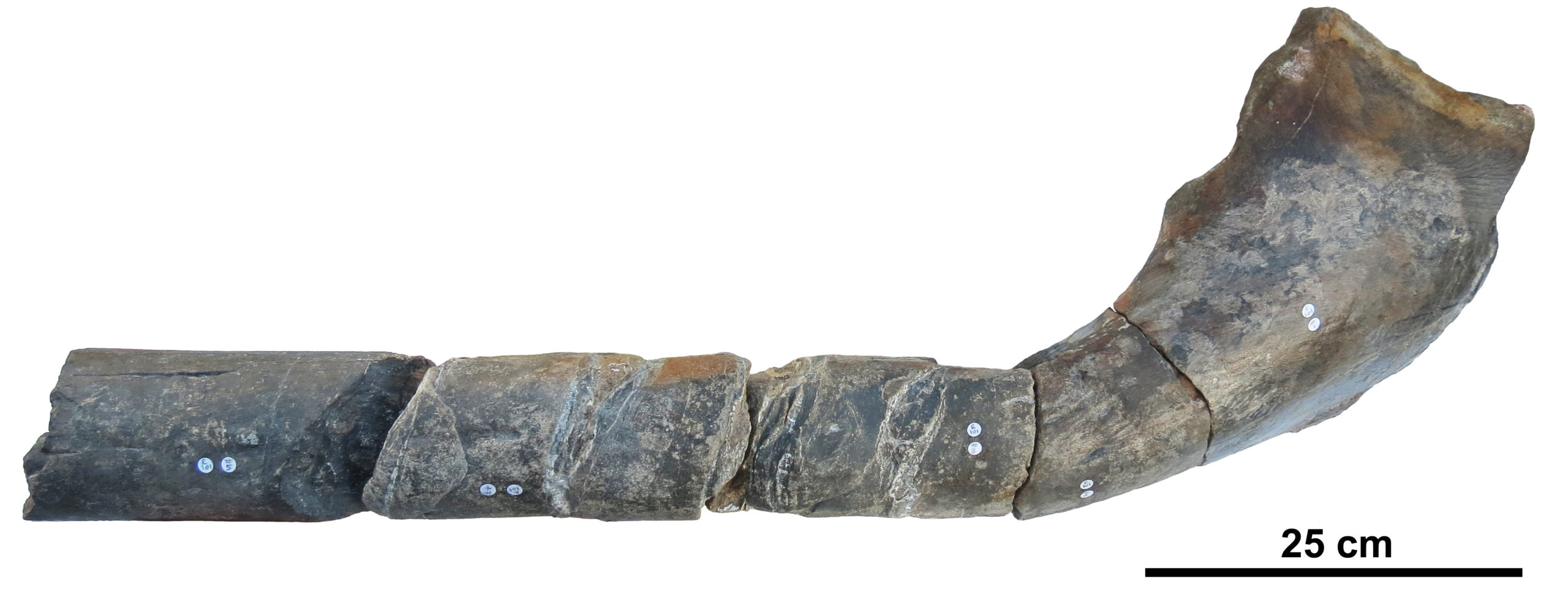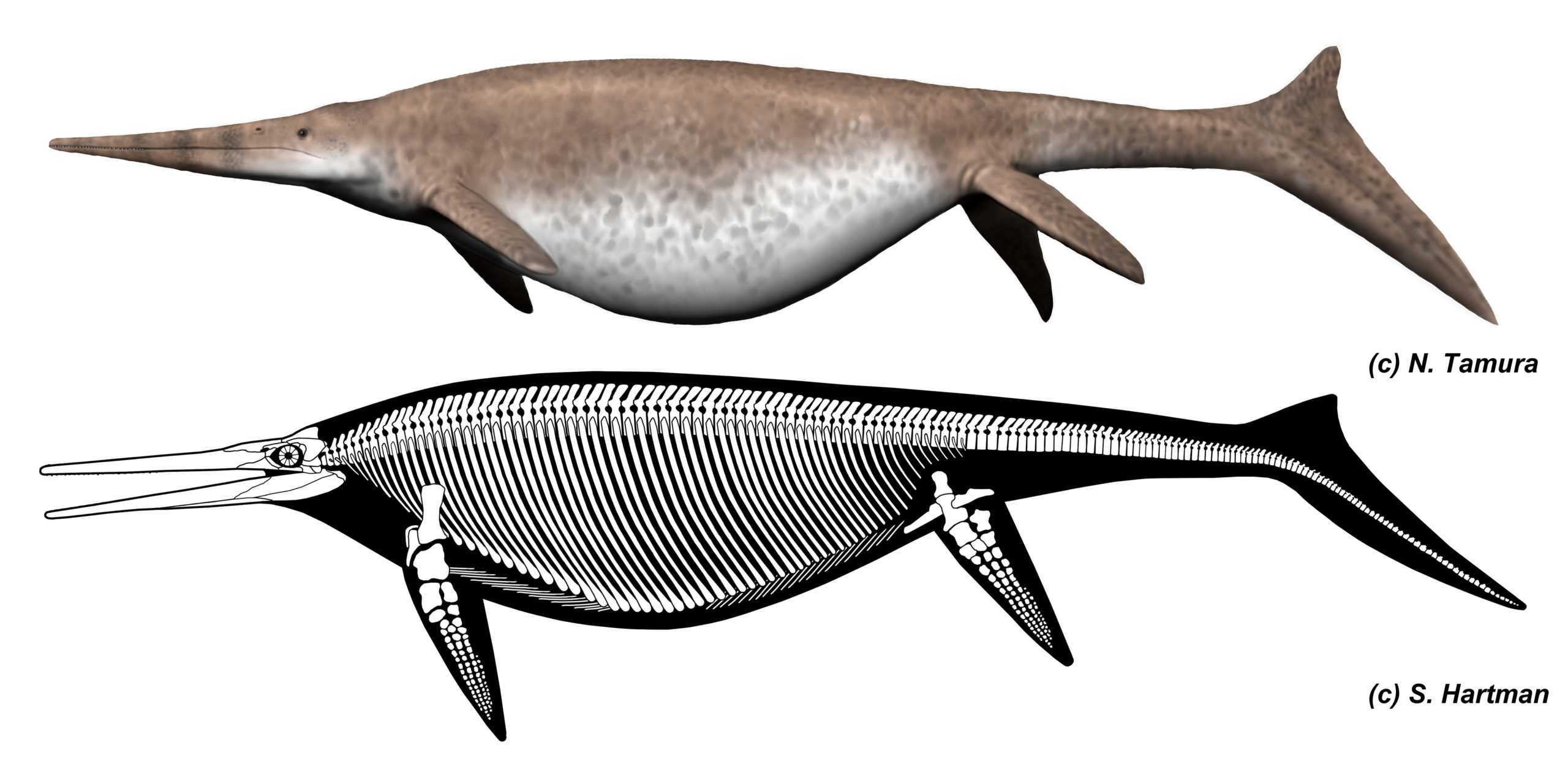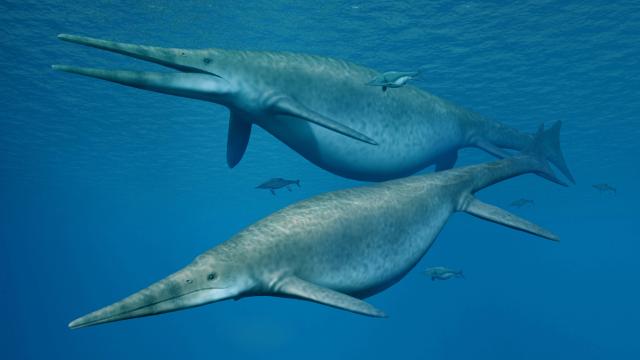Palaeontologists working along the UK’s southwest coast have unearthed a 205-million-year-old jawbone that belonged to an absolutely enormous species of ichthyosaur, a very successful group of aquatic reptiles. At approximately 26m in length, these monsters were one of the largest animals to have ever appeared on Earth.
Artist’s impression of Shonisaurus, a giant ichthyosaur. Illustration: Nobumichi Tamura
No animal, either past or present, has been larger than the modern blue whale – an aquatic mammal that grows to nearly 30m in length. But as new research released today in PLoS One suggests, a prehistoric reptile from the Late Triassic period came awfully close. Based on the discovery of a partial ichthyosaur jaw bone, researchers from the University of Manchester and SUNY College at Brockport, New York, have extrapolated the size of this extinct beast to a whopping 26m in length.
Ichthyosaurs made their first appearance in the Triassic period, surviving through the Jurassic and into the Late Cretaceous. These aquatic reptiles, which gave birth to live young instead of laying eggs, varied greatly in size, and featured body plans similar to today’s dolphins and whales. The new research establishes a new upper bound for these animals in terms of size, ranking them as some of the largest animals to have ever lived.
The specimen was discovered by Paul de la Salle, a fossil collector and a co-author of the new study, who found it on a beach at Lilstock, Somerset, UK. He thought it was just a piece of rock at first, but on closer inspection he saw what appeared to be a groove and bone structure, possibly from the jaw of an ichthyosaur. He brought it to the attention of palaeontologists Dean Lomax and Judy Massare, who confirmed his suspicions. Geologist Ramues Gallois was brought in to date the stratigraphic layer within which the fossil was found, which he determined to be about 205 million years old.

The surangular bone, which came from the animal’s lower jaw. Image: Dean Lomax, The University of Manchester
This bone is called the surangular bone, and it’s part of the animal’s lower jaw. It represents a minuscule portion of the entire ichthyosaur, so it’s admittedly not a lot to go by. To figure out what they were dealing with, the researchers compared the bone to a similar subspecies – the gigantic shastasaurids, which ranged in size from 5.5m to 20m in length. The fossilised remnants of a shastasaurid species, Shonisaurus sikanniensis, is currently kept at the Royal Tyrrell Museum of Palaeontology in Alberta, Canada. By comparing the same bones, the researchers were able to intuit the overall size of the Lilstock specimen.
“As the specimen is represented only by a large piece of jaw, it is difficult to provide a size estimate, but by using a simple scaling factor and comparing the same bone in S. sikanniensis, the Lilstock specimen is about 25 per cent larger,” explained Lomax in a statement. “Other comparisons suggest the Lilstock ichthyosaur was at least 20-25 meters. Of course, such estimates are not entirely realistic because of differences between species. Nonetheless, simple scaling is commonly used to estimate size, especially when comparative material is scarce.”

Artist’s impression, including possible skeletal composition of Shonisaurus. Illustration: Nobumichi Tamura & Scott Hartman
So to be fair, this is a best guess based on a single jawbone. Clearly, more paleontological evidence will be required to suss this out further.
Finally, and as an interesting consequence of this finding, some old fossils found in Aust Cliff, Gloucestershire, UK, in 1850 should now be re-evaluated, the researchers say. These bones were so big that scientist figured they belonged to some unknown dinosaur species. Writing in their new study, Lomax and de la Salle said “isolated, fragmentary bones could be easily mistaken for those of dinosaurs because of their size”, and that the old Aust bones may be “jaw fragments from giant ichthyosaurs”. Ichthyosaurs are not classified as dinosaurs, as dinos feature several distinctive anatomical features, including two holes in the skull behind their eye socket, ankles that bend like a hinge, and limbs held directly under the body. No marine reptiles are considered dinosaurs, in fact.
Ah, science. Always more work to be done.
[PLoS One]
